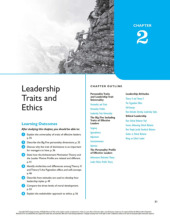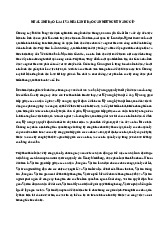


Preview text:
lOMoAR cPSD| 58605085 Nguyễn Đức Duy BABAWE21249 Nguyễn Hà Anh BABAWE20236 Dương Ngọc Anh BABAWE20225 Nguyễn Minh Bảo Ngọc BABAWE20231 Trương Trần Thủy Tiên BABAWE20112
CHAPTER 1: WHO IS LEADER AND WHAT SKILLS DO LEADERS NEED
Leadership is one of the most crucial skills for establishing success for any worldwide organization. For
example, by mastering leadership skills, Jeff Bezos has brought Amazon's reputation to the top of the
world. Therefore, companies nowadays focus on educating employees to be more professional in the
way of leading others through various projects and spend large amounts of money on leadership courses.
They believe that mastering leadership skills can potentially become their competitive advantage and
lead to positive results in the long run. Not only is leadership appropriate for everyone, but individuals
could apply it practically in both the workplace and personal life. Furthermore, whereas being good at
leading would surely be a priority for those aiming to become managers, employees these days also
need to be well-prepared for leading others, including diversely participating in making decisions and working in teams.
During the procedure, followers are controlled and influenced by leaders to reach the highest
performance and achieve corporate objectives through changes. There are five key elements of
leadership. Regarding Leaders-Followers, there may be many leaders in an organization, not just one,
as people usually think. Besides, the leader is one of the managers. A manager will deal with power,
authority, but leaders deal with personal power. Another difference between leaders and managers is
that managers hold formal positions while leaders cannot. In terms of influence, the leaders do
something like communicate, motivate employees, and make sure they implement projects through
changes. The more influence followers get, the more enthusiasm and commitment leaders gain. Clear
goals would be organizational objectives when they both understood the future vision for desirable
performance. Without people, a task cannot be done, so they play a tremendously essential role. Leaders
need to understand followers, get along well with them. Furthermore, although the change in strategies
and structures is new & challenging initially, it brings better outcomes such as improvement and innovation.
Regarding leadership skills, experts estimate that 30% of leadership traits are inherited, and the
remaining 70% are nurtured through personal development efforts, showing the potential of individuals
to enhance their aptitudes as leaders. Success in a leadership role depends on three essential
management competencies: technical, interpersonal, and Decision Making. Technical skills require
using methods and techniques to complete tasks, while interpersonal skills include understanding,
communicating effectively, and fostering effective relationships with individuals and groups. Decision-
making skills involve forming conceptual scenarios, identifying problem-solving alternatives, and seizing opportunities.
In Leadership Managerial Roles, Henry Mintzberg identified ten managerial roles that leaders perform
to accomplish organizational objectives. The roles represent the dominant classes of behavioral lOMoAR cPSD| 58605085
activities that managers or their followers perform. Mintzberg defined a role as a set of expectations of
how a person will behave to perform a job. He grouped these roles into three categories. The managerial
role categories are interpersonal, informational, and decisional.
In interpersonal roles, the interpersonal leadership roles include figurehead, leader, and liaison.
Leaders perform the figurehead role when they represent the organization or department in legal,
social, ceremonial, and symbolic activities. The leader's role is to perform the management functions
to effectively operate the manager's organisation unit. Leaders perform the liaison role when they
interact with people outside of their organizational unit.
In informational roles, the informational leadership roles include monitor, disseminator, and
spokesperson. Leaders perform the monitor role when they gather information. Leaders perform the
disseminator role when they send information to others in the organizational unit. Leaders perform the
spokesperson role when they provide information to people outside the organizational unit.
In Decisional Roles, The decisional leadership roles include entrepreneur, disturbance handler,
resource allocator, and negotiator. Leaders perform the entrepreneur role when they innovate and
initiate improvements. Leaders perform the disturbance-handler role when they take corrective action
during crisis or conflict situations. Leaders perform the resource-allocator role when they schedule,
request authorization, and perform budgeting activities. Leaders perform the negotiator role when they
represent their organizational unit during routine and nonroutine transactions that do not include set
boundaries (such as only one price and term of a sale/purchase for a product/service or the pay of an employee).
On the level of analysis of leadership theory, it combines three vital sub-approaches namely
individual, group, and organization. Together, they provide mutual support in order to build strong
connections and a triangle-shaped framework. When it comes to effectively managing the connection
between leaders and subordinates, if the three aforementioned characteristics are regarded as
components of a home, then the individual is robust. Interestingly, a leader is someone who can bring
out the best in followers, and followers must do the same under the leader's direction. The term "dyadic
process" refers to this procedure. Individuals will go to the group process phase whenever they are able
to connect and assist one another while being led by an individual. The group's significance is contingent
upon the management of this particular stage. The column that establishes a link between the individual
and the business is another crucial component. Ultimately, a strong organization is formed through the
organizing process when groups are able to create intimate bonds with one another. There are both
individuals and groups involved in this process.Subordinates must adjust to the work environment, and
in order for leaders to be effective, they must have all the necessary resources (talents, working capacity,
interpersonal relationships, and group relationships). Effective leadership requires careful control over
each of the three tasks since they are interdependent and complement one another.
The relevance of understanding and categorizing leadership theories is emphasized by discussion of
Leadership theory paradigms. A leadership theory is defined as an explanation of leadership with the
goal of improving comprehension and predicting effective leadership. The attribute, behavioral,
contingency, and integrative theories are the four main categories that are discussed. It also presents
the idea of a leadership paradigm, which is a shared way of thinking that changes over time to reflect
shifts in the way leadership is understood and researched. In this section, the transition from
management to leadership is emphasized.
The idea that leaders are born, not created, is emphasized throughout the text's discussion of the Trait
Theory paradigm in early leadership studies. Researchers examined psychological and physical
characteristics such as energy level, appearance, assertiveness, self-reliance, persuasiveness, and
dominance in an effort to pinpoint the distinct characteristics that set great leaders apart from followers. lOMoAR cPSD| 58605085
The idea was to define a set of characteristics that would be required before elevating someone to a
leadership position; only those who met all of the criteria would be considered qualified for such positions.
In the 1950s, the focus shifted from the theory of traits to behavioral leadership theory, emphasizing the
activities of leaders in the workplace. Through an exploration of different styles and the nature of
management work, researchers aimed to find behavioral differences between both successful and
unsuccessful leaders. Behavioral leadership theory is demonstrated by Mintzberg's ten managerial
positions, which classify behaviors to provide a more in-depth knowledge of leadership. We will explore
common behavioral leadership theories in Chapter 3.
The shift in leadership ideas from universal theories to contingency theories is indicative of the
understanding that effective leadership depends on the setting. Contingency theories emphasize the
importance of flexibility, taking into consideration situational dynamics, follower traits, and the leader's
attributes to choose the best leadership style. Prominent contingency leadership theories are expected
to be covered in detail in Chapter 4, providing information about how these frameworks handle the
many interactions between factors that contribute to effective leadership.
Established in the mid-to-late 1970s, the Integrative Leadership Theory Paradigm aims to understand
successful leader-follower relationships by combining personality traits, behavioral, and contingency
theories. It places a strong emphasis on integrating many ideas to understand the influence of actions
in varied contexts and the effectiveness of leadership. This paradigm informs the content of Chapters 6
through 12 in the related book and has a major influence on how leadership is defined.
The change from management to leadership represents a departure from the traditional authoritarian
paradigm in favor of a participative approach that places an emphasis on creativity and teamwork.
Combining skills in leadership and management, successful leaders recognize how crucial each is to the
success of their organizations. The objective is integration rather than strict classification, realizing that
people with the ability to manage and lead are beneficial to successful businesses. Stereotyping people
as managers or leaders oversimplifies the complexity of leadership and prevents the development of a thorough comprehension.
In reflection, all the theories we mentioned before have scientific pieces of evidence, and it is essential
to develop leadership skills such as the ability to communicate, think logically, apply technologies, and
solve problems relating to cultural differences. It is not enough to gain knowledge. Instead, we need to
know how these theories can be applied in the workplace.



